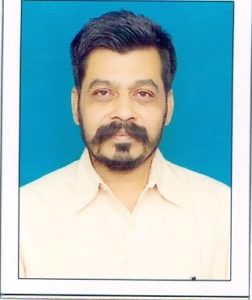
The Indian Chapter of the IGS has been championing geosynthetics for more than 30 years following its formation in October 1988. Here, current Chapter President Vivek Kapadia shares some of its highlights and upcoming initiatives.
Please tell us a bit about your membership.
We have 90 Individual Members, 80 Student Members and 13 Institutional Members. Institutional members consist of manufacturers, research institutes, academic institutions, testing houses and user agencies.
What are your chapter’s key activities?
Our Chapter promotes the application of geosynthetics for various developmental activities in the fields of water resources, hydroelectric power, roads, coastal protection, slope stabilization and so on. We do this through workshops, seminars and webinars, across the country.
Do you have a youth section? Tell us a bit about the initiatives available for younger members.
We encourage student members to join the Chapter by inviting their participation in geosynthetic events and circulating technical journals through the relevant universities or institutions. We have less than 100 young members at the moment but we are focused on growing this number.
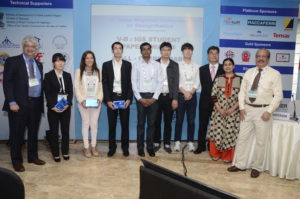
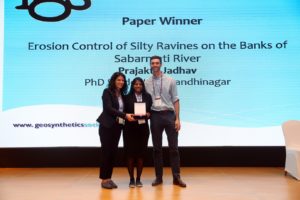
Young Member Paper Award – Seoul 2018
What are you proud of in the chapter?
The activities of the Indian Chapter are really noteworthy and a matter of pride. From its inception it has been promoting the application of geosynthetics for various developmental activities in the field of water resources, hydroelectric power, roads, coastal protection, slope stabilization and so on. Many case studies were compiled in ‘History of Geosynthetics in India – Case Studies’. This was jointly published by IGS India and the Central Board of Irrigation and Power (the Secretariat of IGS India) for the 6th Asian Regional Conference on Geosynthetics in New Delhi in November 2016.
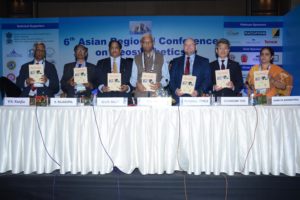
The Indian Chapter also had the honor of hosting the first Asian Regional Conference on Geosynthetics in 1997 in Bangalore. We also enjoyed celebrating our Silver Jubilee in October 2013 in New Delhi. And in 2016 we hosted the Sixth Asian Regional Conference on Geosynthetics in New Delhi.
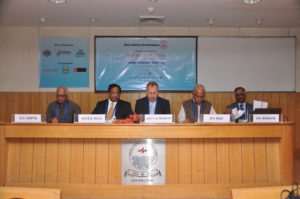
Our chapter also recently hosted a Special Session on ‘Use of Geosynthetic Material for Dam Repair and Rehabilitation’, on February 26 during the Indian National Committee on Large Dams (INCOLD) Symposium on ‘Sustainable Development of Dams and River Basins’.
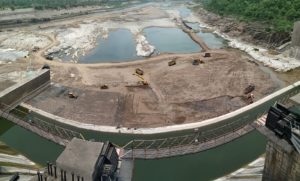
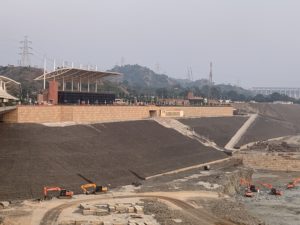
IGS India members have been awarded the IGS Student Paper Award over previous years. They include:
-
- Dr. J.P. Sampath Kumar, National Institute of Fashion Technology, Hyderabad
- Dr. K. Ramu, JNTU College of Engineering, Kakinada
- S. Jayalekshmi, National Institute of Technology, Tiruchirappalli
- Dr. Mahuya Ghosh, Indian Institute of Technology Delhi
- Dr. S. Rajesh, Department of Civil Engineering, Indian Institute of Technology Kanpur
- Suresh Kumar S., Department of Textile Technology, and Dr. B.R. Ambedkar National Institute of Technology Jalandhar
Dr. Riya Bhowmik, Post-Doctoral Fellow, Department of Civil Engineering, Indian Institute of Technology Delhi, has been selected by the Indian Chapter for the IGS Student Paper Award 2021 to be presented during 7th Asian Regional Conference on Geosynthetics in Taiwan, In April 2022.
Publications are important to your chapter. Please share some of the most significant ones.
Absolutely. Some of the important publications brought out by our chapter, in addition to proceedings from our workshops, short courses, conferences and seminars, include:
-
- Use of Geosynthetics – Indian Experiences and Potential – A State of Art Report (1989)
- Use of Geotextile in Water Resources Projects – Case Studies (1992)
- Directory of Geosynthetics in India
- An Introduction to Geotextiles and Related Products in Civil Engineering Applications (1994)
- Ground Improvement with Geosynthetics (1995)
- Geosynthetics in Dam Engineering (1995)
- Erosion Control with Geosynthetics (1995)
- Bibliography – The Indian Contribution to Geosynthetics (1997)
- Waste Containment with Geosynthetics (1998)
- Geosynthetics – Recent Developments (Commemorative Volume) (2006)
- Geosynthetic Reinforced Soil Structures – Design & Construction (2012)
- Applications of Geosynthetics in Railway Track Structures (2013)
- Three Decades of Geosynthetics in India – A Commemorative Volume (2015)
- History of Geosynthetics in India – Case Studies (2016)
- Coir Geotextiles (Coir Bhoovastra) for Sustainable Infrastructure (2016)
- Geosynthetics Testing – A Laboratory Manual (2019)
We have also published the Indian Journal of Geosynthetics and Ground Improvement (IJGGI) since January 2012 and it is available twice a year (January – June and July-December) in both print and online. The aim is to provide the latest information about developments taking place in the relevant field of geosynthetics to improve communication and understanding among designers, manufacturers and users and especially between the textile and civil engineering communities.
In all, the India Chapter has really contributed a lot to the field of geosynthetics and has enormous potential to do much more. It really is a matter of pride.
Tell us a bit about the geosynthetics market in India. What is the level of understanding and adoption of geosynthetics?
Understanding and adoption are both improving with time. Complex applications are underway and many such projects are upcoming such as energy dissipation mechanisms in dams, the repair of concrete dams, and harbor structures.
Where are the areas of most opportunity?
Road engineering and coastal engineering applications provide good opportunities because of the large quantities of geosynthetics used in such projects.
And what are the challenges?
The present challenge of the pandemic has made a big dent on projects and hence the effect is felt on production as well.
Is the industry concentrated in particular regions in India?
Industries are located on a pan-India scale. However, industries manufacturing natural products from jute and coir are located on the southern coast and eastern coast of India.
Can you tell me a bit more about jute and coir products used with geosynthetics?
Jute and coir are natural fibers from which various products are manufactured and used in several applications. As environmental friendly materials, they are used in projects where environmental concerns are very important.
Can you share any notable projects in India that have used geosynthetics? And also any projects in the pipeline?
The Shillong bypass road in east India connecting National Highway 40 and National Highway 44 with length of 48.766 km and an embankment height of more than 40m was completed in 2014. It is a reinforced earth embankment.
A road project on National Highway 55, Siliguri-Darjeeling Road in West Bengal was completed in January this year. Its maximum height is 102.8m and is the world’s tallest Reinforced Earth® structure.
In hilly areas, the most challenging projects with innovative solutions have been carried out using geosynthetics. Besides these, several hydraulic structures have been constructed or repaired using geosynthetics. The High Speed Railway Project between Ahmedabad and Mumbai on the western side of India is being constructed in which geosynthetics are being used in many stretches.
What does the future hold for geosynthetics in India?
I see a bright future of geosynthetics in India as several projects are in the pipeline and the manufacturing industry is also improving.
What chapter events or activities are planned in 2021 (or beyond) for members?
Webinars on ‘Design and Construction of Pavements with Geosynthetics’, ‘Reinforced Soil Slopes and Walls’ and ‘Applications of Geosynthetics in Hydraulic Structures’ have been planned. The dates and times will be confirmed in due course.
Is there anything else you would like to add?
I expect very interesting, challenging and innovative applications to come up in the near future in India. Stay tuned!
For more about IGS India, visit its website here.





















